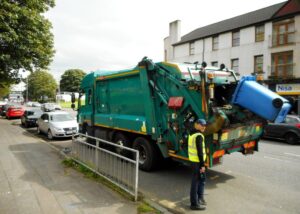Current Management Structure
Proper management of waste is important for building sustainable and livable cities, but it remains a challenge for many developing countries and cities.
we are explaining current situation in Mumbai area,
Waste management responsibility is taken formally by the MCGM. The current mechanism involves collection , transport and disposal strategy. Waste is collected from different areas in Mumbai and sent to disposal at 3 dumping ground (Deonar, Mulund and Gorai )sites which are currently services the city and are already overburdened with waste. The following mechanism explains the present structure.
A large portion of waste management practices deal with municipal Solid Waste (MSW) which is the bulk of the waste that is created by household, industrial, and commercial activity.
Waste Management provides solid waste collection services for residential, industrial, municipal and commercial customers .
The garbage collectors employed by various housing societies, entities etc. collect the garbage on door to door basis and dump it near the community bins strategically placed at various areas. There are more than 5800 community bins in Mumbai alone. Here manual or mechanical compactors are used to collect waste from such community bins and and then sent to a transfer station. In case of Mumbai the transfer stations are located at Mahalaxmi, Kurla and Versova. The transfer stations are basically stations for smaller vehicles that bring the garbage from point sources and community bins. The garbage is thus transferred from smaller vehicles to larger vehicles capable of transferring the waste towards the disposal sites.
Various types of vehicles are used to transport the garbage. Those include open flat-bed trucks, covered trucks, mobile compactors, tarpaulin covered vehicles .
Tarpaulin garbage (construction debris carrier)
A garbage truck (closed bed )
In Mumbai
Dispose of waste:
Waste Management has the largest number of landfills in the industry. Utilizing the most advanced engineering, construction and monitoring methods, these landfills serve the disposal needs of geographic markets across the U.S. and Canada and adhere to the highest standards of safety and environmental responsibility.
Composting
Composting signifies biological decomposition of organic material. Microorganisms decompose the organic material to a stabilized product, i.e. compost. The end product can be used as soil conditioner. The compost generated consists of useful bacteria which can help plants with numerous benefits such as nitrogen fixation, helps soil for water retention, adds nitrogen, phosphorus and potassium. Thus benefits of compost are numerous and unlike the above alternatives this method seems viable and sustainable in the long run. It is also in sync with nature in general. Composting has the following benefits to agriculture and environment.
Environment
-
Directs waste away from landfills resulting in less accumulation of garbage and reduces leachate production (which could contaminate underground resources )
-
Reduces foul odors
-
Avoids methane production in landfills
-
Helps in afforestation programmes and increases the survivability of plants.
-
Reduces need for landfill space*
Agriculture
Helps maintain soil ph levels
Adds organic matter, humus which supplements the soil.
Reduces fertilizer requirement
Provides a market for compost making and selling thus creating an extra income for the farmers
Compost attracts earthworms thus helping in better soil aeration.
Helps restore soil conditions as microbes are affected with high usage of chemical fertilizers.
About 95% of waste generated in the city is disposed in such manner.Now multiple Techniques invented to dispose waste and reuse or recycle. there are many machines and methods are there to dispose waste collected waste can disposed later on on dumping ground or reuse by machines.


